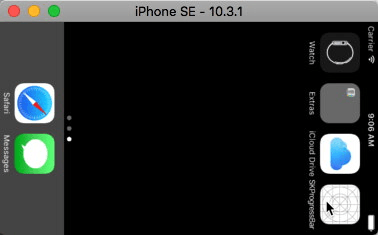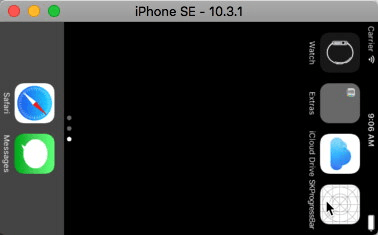Swift 4
( my answer 3 -> old SpriteBar project fully translated to swift)
To make a progress bar based to SKTextureAtlas you can use the Objective C project called SpriteBar maded by Henry Everett.
I've forked and fully translated this project, this is the source:
class SpriteBar: SKSpriteNode {
var textureReference = ""
var atlas: SKTextureAtlas!
var availableTextureAddresses = Array<Int>()
var timer = Timer()
var timerInterval = TimeInterval()
var currentTime = TimeInterval()
var timerTarget: AnyObject!
var timerSelector: Selector!
init() {
let defaultAtlas = SKTextureAtlas(named: "sb_default")
let firstTxt = defaultAtlas.textureNames[0].replacingOccurrences(of: "@2x", with: "")
let texture = defaultAtlas.textureNamed(firstTxt)
super.init(texture: texture, color: .clear, size: texture.size())
self.atlas = defaultAtlas
commonInit()
}
convenience init(textureAtlas: SKTextureAtlas?) {
self.init()
self.atlas = textureAtlas
commonInit()
}
func commonInit() {
self.textureReference = "progress"
resetProgress()
}
required init?(coder aDecoder: NSCoder) {
fatalError("init(coder:) has not been implemented")
}
func closestAvailableToPercent(_ percent:Int)->Int {
var closest = 0
for thisPerc in self.availableTextureAddresses {
if labs(Int(thisPerc) - percent) < labs(closest - percent) {
closest = Int(thisPerc)
}
}
return closest
}
func percentFromTextureName(_ string:String) -> Int? {
let clippedString = string.replacingOccurrences(of: "@2x", with: "")
let pattern = "(?<=\(textureReference)_)([0-9]+)(?=.png)"
let regex = try? NSRegularExpression(pattern: pattern, options: .caseInsensitive)
let matches = regex?.matches(in: clippedString, options: [], range: NSRange(location: 0, length: clippedString.count))
// If the matches don't equal 1, you have done something wrong.
if matches?.count != 1 {
NSException(name: NSExceptionName(rawValue: String("SpriteBar: Incorrect texture naming.")), reason: "Textures should follow naming convention: \(textureReference)_#.png. Failed texture name: \(string)", userInfo: nil).raise()
}
for match: NSTextCheckingResult? in matches ?? [NSTextCheckingResult?]() {
let matchRange = match?.range(at: 1)
let range = Range(matchRange!, in: clippedString)!
return Int(clippedString[range.lowerBound..<range.upperBound])
}
return nil
}
func resetProgress() {
self.texture = self.atlas.textureNamed("\(self.textureReference)_\(closestAvailableToPercent(0)).png")
self.availableTextureAddresses = []
for name in self.atlas.textureNames {
self.availableTextureAddresses.append(self.percentFromTextureName(name)!)
}
self.invalidateTimer()
self.currentTime = 0
}
func setProgress(_ progress:CGFloat) {
// Set texure
let percent: CGFloat = CGFloat(lrint(Double(progress * 100)))
let name = "\(textureReference)_\(self.closestAvailableToPercent(Int(percent))).png"
self.texture = self.atlas.textureNamed(name)
// If we have reached 100%, invalidate the timer and perform selector on passed in object.
if fabsf(Float(progress)) >= fabsf(1.0) {
if timerTarget != nil && timerTarget.responds(to: timerSelector) {
typealias MyTimerFunc = @convention(c) (AnyObject, Selector) -> Void
let imp: IMP = timerTarget.method(for: timerSelector)
let newImplementation = unsafeBitCast(imp, to: MyTimerFunc.self)
newImplementation(self.timerTarget, self.timerSelector)
}
timer.invalidate()
}
}
func setProgressWithValue(_ progress:CGFloat, ofTotal maxValue:CGFloat) {
self.setProgress(progress/maxValue)
}
func numberOfFrames(inAnimation animationName: String) -> Int {
// Get the number of frames in the animation.
let allAnimationNames = atlas.textureNames
let nameFilter = NSPredicate(format: "SELF CONTAINS[cd] %@", animationName)
return ((allAnimationNames as NSArray).filtered(using: nameFilter)).count
}
func startBarProgress(withTimer seconds: TimeInterval, target: Any?, selector: Selector) {
resetProgress()
timerTarget = target as AnyObject
timerSelector = selector
// Split the progress time between animation frames
timerInterval = seconds / TimeInterval((numberOfFrames(inAnimation: textureReference) - 1))
timer = Timer.scheduledTimer(timeInterval: timerInterval, target: self, selector: #selector(self.timerTick(_:)), userInfo: seconds, repeats: true)
}
@objc func timerTick(_ timer: Timer) {
// Increment timer interval counter
currentTime += timerInterval
// Make sure we don't exceed the total time
if currentTime <= timer.userInfo as! Double {
setProgressWithValue(CGFloat(currentTime), ofTotal: timer.userInfo as! CGFloat)
}
}
func invalidateTimer() {
timer.invalidate()
}
}
Usage:
let progressBarAtlas = SKTextureAtlas.init(named: "sb_default")
self.energyProgressBar = SpriteBar(textureAtlas: progressBarAtlas)
self.addChild(self.energyProgressBar)
self.energyProgressBar.size = CGSize(width:350, height:150)
self.energyProgressBar.position = CGPoint(x:self.frame.width/2, y:self.frame.height/2)
let wait = SKAction.wait(forDuration: 2.0)
let action1 = SKAction.run {
self.energyProgressBar.setProgress(0.7)
}
let action2 = SKAction.run {
self.energyProgressBar.setProgress(0.0)
}
let action3 = SKAction.run {
self.energyProgressBar.setProgress(1.0)
}
let action4 = SKAction.run {
self.energyProgressBar.setProgress(0.5)
}
let action5 = SKAction.run {
self.energyProgressBar.setProgress(0.1)
}
let action6 = SKAction.run {
self.energyProgressBar.startBarProgress(withTimer: 10, target: self, selector: #selector(self.timeOver))
}
let sequence = SKAction.sequence([wait,action1,wait,action2,wait,action3,wait,action4,wait,action5,wait,action6])
self.run(sequence)
To have more details you can find my GitHUB repo here







+(SKTexture *)textureWithRect:inTexture:– Luganda